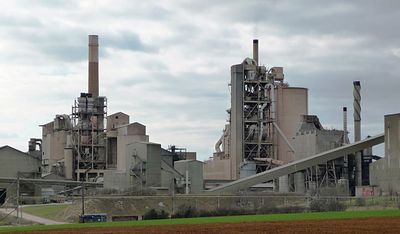Ketton Cement Kiln: Difference between revisions
No edit summary |
No edit summary |
||
| Line 1: | Line 1: | ||
[[Ketton Cement Kiln]] is located in Stamford and is owned by [[Hanson]]. | [[Ketton Cement Kiln]] is located in Stamford and is owned by [[Hanson Cement]]. | ||
{{CementKiln|EPR=BM0486IT|id=6}} | {{CementKiln|EPR=BM0486IT|id=6}} | ||
[[Category:Cement Kilns]] | [[Category:Cement Kilns]] | ||
Revision as of 15:35, 15 August 2022
Ketton Cement Kiln is located in Stamford and is owned by Hanson Cement.
| Ketton Cement Kiln | |
 See Cement Kilns → page for a larger UK Wide map. | |
| Waste Licence | BM0486IT |
| Operator | Hanson Cement |
| Parent Company | Heidelberg Cement Group |
| Clinker Capacity | 1.4 Mt |
Summary site information collated from a variety of sources.

Overview
WikiWaste has used the website Cement Plants and Kilns in Britain and Ireland[1] extensively for the reference material for each individual cement kiln page. The detail on this reference website is extensive and as WikiWaste is focused upon the UK waste and resource market, only the key highlights are captured from this website (and company websites accordingly) to provide background and context. Ketton started manufacturing clinker in 1929 and up to 2015 had produced 56 million tonnes of clinker through 8 rotary kilns over this period.
Ownership
- 1929 to 1986 Ketton Portland Cement Co. Ltd (owned by Thomas W Ward and Co Ltd to 1981, then Rio Tino Zinc (RTZ))
- 1986 to 2009 Castle Cement Ltd (RTZ to 1989, Scancem to 1999, HeidlebergCement to 2009)
- 2009 to Present Hanson Cement UK (owned by HeidelbergCement)
The Process at Ketton
The process at the site is similar to that at Cookstown - a 'semi-dry process' from kiln supplier Polysius (part of the ThyssenKrupp group).
Raw Materials
The primary raw materials are Great Oolite and Yellow Inferior Oolite Limestone, with Great Oolite Shale and Upper Lias Shale all from the same nearby quarry.
Waste Tonnage, EWC List
The table shows a list of the Waste for the Permit BM0486IT, that has arrived into sites as reported to the Regulator and then publicised in their reported statistics. The Data was last updated in Oct-24. The total reported tonnage arriving at the site was: 135,769.8t.
| EWC Code | Description | Tonnes In |
|---|---|---|
| 10 03 30 | wastes from treatment of salt slags and black drosses other than those mentioned in 10 03 29 | 4198.7 |
| 19 02 08* | liquid combustible wastes containing dangerous substances | 19858.1 |
| 19 04 01 | vitrified waste | 12312.8 |
| 19 09 02 | sludges from water clarification | 3189.5 |
| 19 12 10 | combustible waste (refuse derived fuel) | 96210.7 |
Waste Tonnage, By Origin
The table shows a list of the Waste for the Permit BM0486IT, that has arrived into sites as reported to the Regulator and then publicised in their reported statistics. The Data was last updated on Oct-24. The total reported tonnage arriving at the site was: 135,769.8t.
Where this tonnage exceeds that reported in year of the corresponding annual report, this may be due to the following reasons:
- Tonnage may have been received but not incinerated, i.e. the material is held pending incineration (the operator return to the EA reports as received whereas the annual report focuses on when the waste is incinerated.)
- Material may have been received into the site but treated in some other way than incineration.
- Material may have been received on the but transferred out of site for disposal/treatment at another site rather than incineration on the site.
| EWC Code | Origin of Waste | Tonnes In |
|---|---|---|
| 10 03 30 | Staffordshire | 4198.7 |
| 19 02 08* | Ashfield | 4232.5 |
| 19 02 08* | Lancaster | 15625.6 |
| 19 04 01 | Redcar and Cleveland | 12312.8 |
| 19 09 02 | Rutland | 3189.5 |
| 19 12 10 | Spelthorne | 94985.4 |
| 19 12 10 | Stockton-on-Tees | 1225.3 |
Around 90% of the tonnage listed was used for the primary purpose of substituting fuel requirements in the plant, with coal fly ash (also called Pulverized Fuel Ash or PFA) used as a replacement for raw material in the production process. Hanson intend to 'continuously increase' the use of alternatives as part of their 2030 commitments[2].
